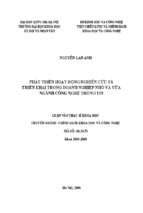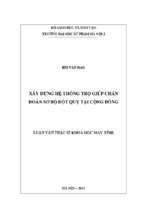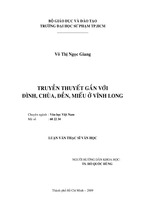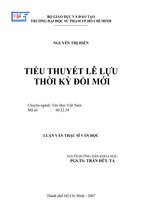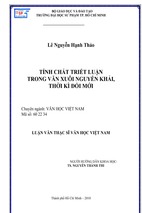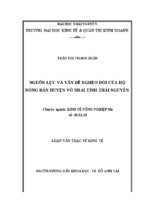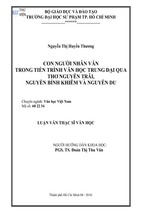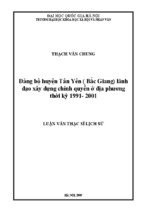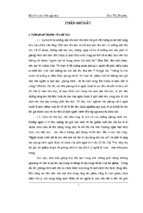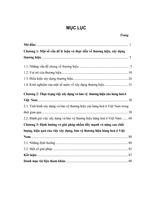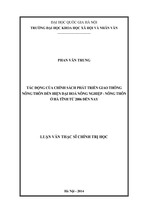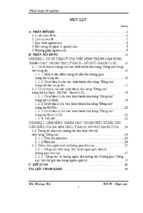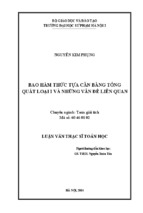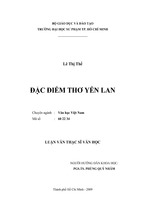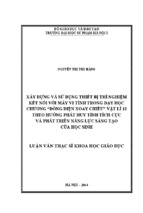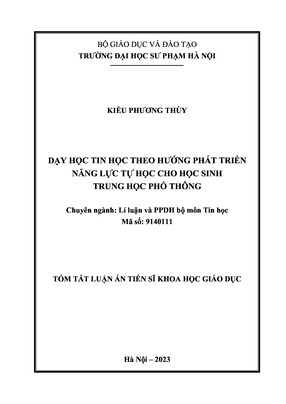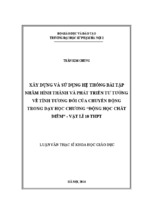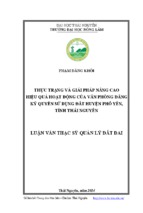BỘ GIÁO DỤC VÀ ĐÀO TẠO
TRƢỜNG ĐẠI HỌC CÔNG NGHỆ ĐỒNG NAI
BÁO CÁO TỔNG KẾT
ĐỀ TÀI NGHIÊN CỨU KHOA HỌC CẤP TRƢỜNG
A SURVEY ON STUDENTS' OPINION ABOUT E-LEARNING AT
DONG NAI TECHNOLOGY UNIVERSITY
(NGHIÊN CỨU VỀ THÁI ĐỘ CỦA SINH VIÊN TRƢỜNG ĐẠI HỌC
CÔNG NGHỆ ĐỒNG NAI ĐỐI VỚI VIỆC HỌC E-LEARNING)
Mã số: TR:2020-04/NN
Chủ nhiệm đề tài: ThS. Trần Thị Phƣơng Thƣ
Đồng Nai, 5/2021
BỘ GIÁO DỤC VÀ ĐÀO TẠO
TRƢỜNG ĐẠI HỌC CÔNG NGHỆ ĐỒNG NAI
BÁO CÁO TỔNG KẾT
ĐỀ TÀI NGHIÊN CỨU KHOA HỌC CẤP TRƢỜNG
A SURVEY ON STUDENTS' OPINION ABOUT E-LEARNING AT
DONG NAI TECHNOLOGY UNIVERSITY
(NGHIÊN CỨU VỀ THÁI ĐỘ CỦA SINH VIÊN TRƢỜNG ĐẠI HỌC
CÔNG NGHỆ ĐỒNG NAI ĐỐI VỚI VIỆC HỌC E-LEARNING)
Mã số: TR:2020-04/NN
Chủ nhiệm đề tài
Trần Thị Phƣơng Thƣ
Đồng Nai, 5/2021
DANH SÁCH THÀNH VIÊN THAM GIA
STT
HỌ TÊN
ĐƠN VỊ
VAI TRÒ
1
Trần Thị Phương Thư
Khoa Ngoại Ngữ
Chủ nhiệm đề tài
2
Lê Hồ Bảo Hân
Khoa Ngoại ngữ
Thành viên
3
Phạm Tiểu Hàn
Khoa Ngoại ngữ
Thành viên
TABLE OF CONTENTS
CHAPTER 1: INTRODUCTION ........................................................................................ 1
1.1 Background of the study ................................................................................................ 1
1.2 Statement of the study ................................................................................................... 1
1.3 Research objectives ....................................................................................................... 2
1.4 Research questions ........................................................................................................ 2
1.5 Significance of the study ............................................................................................... 3
CHAPTER 2: LITERATURE REVIEW............................................................................. 4
2.1. Definition of E-learning ............................................................................................... 4
2.1.1. Types of E-learning ................................................................................................... 5
2.1.2. Forms of E-learning .................................................................................................. 6
2.2. Advantages and disadvantages of E-learning ............................................................... 7
2.3.
Related studies ........................................................................................................... 8
CHAPTER 3: RESEARCH METHODOLOGY ............................................................... 10
3.1 Context of the study ..................................................................................................... 10
3.2 Participants of the study .............................................................................................. 10
3.3 Research tool ............................................................................................................... 10
3.4 Data collection procedure ............................................................................................ 11
CHAPTER 4: FINDING AND RESULT.......................................................................... 12
4.1 Personal Information ................................................................................................... 12
4.2 Perceived Usefulness of E-Learning ........................................................................... 14
4.3 Features of E-learning ................................................................................................. 15
4.4 Cost of E-learning ........................................................................................................ 17
4.5 Attitude Towards E-Learning ...................................................................................... 17
4.6 Discussion .................................................................................................................... 18
4.6.1 What are the advantages and disadvantages of E-learning? ................................... 18
4.6.2 What are perceptions of DNTU students about E-learning? ................................... 20
CHAPTER 5: CONCLUSION AND RECOMMENDATION ......................................... 22
5.1 Conclusions ................................................................................................................. 22
5.2 Recommendations ....................................................................................................... 23
REFERENCE .................................................................................................................... 24
APPENDIX ....................................................................................................................... 28
THÔNG TIN KẾT QUẢ NGHIÊN CỨU
ĐỀ TÀI NGHIÊN CỨU KHOA HỌC CẤP TRƢỜNG
1. Thông tin chung:
(dùng cho Báo cáo tổng kết đề tài)
- Tên đề tài: A survey on students' opinion about E-learning at Dng Nai Technology
University (Nghiên cứu về thái độ của sinh viên DNTU đối với việc học E-learning)
- Mã số: TR:2020-04/NN
- Chủ nhiệm đề tài: Trần Thị Phương Thư
Điện thoại: 09190889614
Email:
[email protected]
- Đơn vị quản lý về chuyên môn: TBM Ngữ học & Văn hóa, Khoa Ngoại ngữ
- Thời gian thực hiện: 8/2020 – 1/2021
2. Mục tiêu:
Đề tài nghiên cứu được tiến hành để khảo sát ý kiến của sinh viên trường Đại học Công
nghệ Đồng Nai về việc học E-learning.
3. Nội dung chính:
Đề tài tìm hiểu những thuận lợi và khó khăn của sinh viên DNTU khi học E-learning,
khảo sát mức độ hài lòng/yêu thích của sinh viên đối với các phần mềm/ứng dụng được
sử dụng để học E-learning tại DNTU và tìm hiểu quan điểm của sinh viên về các khía
cạnh khác khi tham gia học E-learning; với các phần chính như sau:
Phần 1: Giới thiệu tổng quan tình hình nghiên cứu thuộc lĩnh vực đề tài ở trong và ngoài
nước (tính cấp thiết; mục tiêu; cách tiếp cận)
Phần 2: Nội dung nghiên cứu gồm phương pháp nghiên cứu, đối tượng và phạm vi
nghiên cứu
Phần 3: Kết luận và kiến nghị
Phần 4: Tài liệu tham khảo
Phần 5: Phụ lục
4. Kết quả chính đạt đƣợc:
- Đa phần sinh viên đồng ý rằng E-learning giúp sinh viên linh động về thời gian và địa
điểm học tập, đồng thời cũng dễ dàng tiếp cận bài giảng và cũng như nhận được sự hỗ trợ
nhiệt tình từ nhà trường và giảng viên.
- Một số khó khăn nhất định mà sinh viên gặp phải như môi trường tại gia đình không
phù hợp cho việc học, trục trặc về đường truyền internet hoặc sự thiếu kỹ thuật tương tác
online của sinh viên.
- Trong số các ứng dụng E-learing đã và đang được sử dụng trong thời gian gần đây tại
DNTU thì CANVAS là ứng dụng được sinh viên sử dụng nhiều nhất và cũng được đại đa
số sinh viên yêu thích (hơn 90%), tiếp theo đó là MS TEAMS và MOODLE.
- Nghiên cứu cũng chỉ ra được rằng sinh viên có thái độ tích cực đối với việc học Elearning, 43,3% sinh viên được khảo sát thích việc học E-learning và 50% vẫn giữ thái độ
trung lập. Về vấn đề chi phí của việc tham gia lớp học E-learning so với lớp học truyền
thống thì có 30% sinh viên được khảo sát cho rằng học E-learning tiết kiệm chi phí hơn,
60% giữ thái độ trung lập và chỉ có 10% cho rằng học E-learning tốn kém hơn. Và có hơn
80% số sinh viên được nghiên cứu ủng hộ việc học E-learning trong tương lai.
CHAPTER 1: INTRODUCTION
1.1 Background of the study
The electronic learning [e-learning] can be defined as a means of education that
incorporates electronic equipment and tools and the interactivity that occurs between
these and the people involved in the educational process. E-learning is a new
application being put into teaching and learning by DNTU for students. Helping
students get used to learning online. For learning E-learning, there will be many
different ideas. Some people think it is inappropriate, but others think it is necessary.
Because of that we need to have a survey on student’s opinions about E-learning at
DNTU. More and more E-Learning projects are being developed lately and some
spectacular successes are recorded. With the rapid speed of technological and
economic developments and penetration into educational systems has lead to greater
demands of making automated learning systems available to learners. E-learning is
changing the way teaching and learning is taking place on university campuses. At
DNTU, E-learning is being applied to teaching and learning more than 1year ago.
Thus, the main aim of the study was to understand the students perception towards
this new concept of E-learning by determining the usefulness as well as its benefits
and challenges from student’s DNTU view. Therefore, this study need evaluation
research to understand the perception about e-learning from students’ point. The
results can be used to bring about the changes needed by incorporating newer
techniques and tools into students learning environments.
1.2 Statement of the study
The advancement of Information Technology (IT) has affected the ways work are
done, its influence on teaching and learning, thus becomes increasingly complex and
widespread. The use of latest technology means that one no longer needs to be in a
regular classroom in order to be educated. Teaching and learning can be done with the
help of technology - E-learning. The term E-learning has been widely used in
education since the mid-1990s. Some researchers view E-learning as the delivery of
teaching
1
materials via electronic media, such as internet, intranets and extranets, satellite
broadcast, audio/video tape, interactive TV, and CD-ROM (Engelbrecht, 2005).
Others also see e-learning as internet based learning which utilizes web-based
communication, collaboration, knowledge transfer, and training to add value to
individuals and to organizations they work within (Kelly & Bauer, 2004). The
application of E-learning in developing countries has gradually advanced in recent
years with an improved availability of Internet connections, local area networks, and
IT support (Omidinia, Masrom, & Selamat, 2011; Tedre, Ngubuke, & Kempainnen,
2010; Williams, Mayer, & Minges, 2011). Statistical analysis was performed to assess
students' personal perspectives on E-learning, and their advantages and disadvantages
in E-learning, and their accessibility to technology, used technology for learning,
technology use skills and technology satisfaction.
1.3 Research objectives
The potential of E-learning is said to be very high, moreover, it is gradually being
introduced into universities and high schools. Furthermore, some students have shown
an interest in participating in online learning, to continue their research, this has
prompted students to look for E-learning opportunities offered by institutions abroad.
It is believed that, over time, many educational institutions will want to consider
introducing E-learning as part of the national education system of students about Elearning. First, we will survey students who have learned through E-learning at
DNTU. We will take each student's opinion and make statistics about what they have
experienced while studying E-learning. Second, we will let them fill out the survey
that we have created to get more details. From there we will find it easier to
summarize student opinions at DNTU. Next, we will ask a few more questions related
to E-learning. Because that will give us a variety of opinions and the survey will
become richer and more informative.
1.4 Research questions
In order to address the research objective, the following research questions are posed:
What are the advantages and disadvantages of E-learning?
2
What are perceptions of DNTU students about E-learning?
The first research question shows their advantages and disadvantages regarding Elearning, it can help them reach their educational level. The second research question
focuses on understanding what students' opinion of E-learning is.
1.5 Significance of the study
It is important that this study helps explore and explain students' concerns and
opinions about e-learning; shed any expectations and experiences they might have in
their meeting with E-learning. The recommendation of this study is that the findings
presented here will be of interest to any educational institution that wants to
implement this teaching and learning approach, assisting them to consider those
concerns and in the process makes E-learning attractive to students. In addition, the
purpose of this study is to help us learn more about how students are learning about Elearning and whether the quality of teaching is effective. It also tells us more about
students' most honest feelings about E-learning at DNTU. That makes our study more
reliable and quality. This study is only for students at DNTU so that they can freely
express their opinions about E-learning during the time they have studied on Elearning.
3
CHAPTER 2: LITERATURE REVIEW
This chapter covers the definitions of the term 'E-learning', it also includes a
discussion of three types of E-learning: fully- online, combined (also known as
blended or mixed mode) and web-assistance. Two forms of E-learning available synchronous and asynchronous, and the different tools that make them workable are
also examined. This chapter also examines the advantages and disadvantages of elearning. Finally, there are discussion of previous studies relating to this topic.
2.1. Definition of E-learning
Electronic learning (E-learning for short) is supported by electronic devices and the
Internet. E-learning enables self-paced learning, in which learners access pre-designed
learning resources any time, from any place.
E-learning has been variedly defined by researchers, including the following - it is the
use of computer network technology, primarily over or through the internet, to deliver
information and instructions to individuals (Ong & Lai, 2006; Welsh et al., 2003).
Another similar definition is one that sees E-learning as any form of education that is
facilitated by the internet and its technologies, and encompasses the use of the World
Wide Web (www) to support instruction and to deliver course content (Masrom,
2007).
The second set of definition view of E-learning as learning facilitated and supported
through the utilization of information and communication technologies (Jenkins &
Hanson, 2003). E- learning is further defined as instruction delivered via a computer
that is intended to promote learning (Clark & Mayer, 2003).
Thirdly E-learning is defined as “the use of new multimedia technologies and the
internet to improve the quality of learning by facilitating access to resources and
services, as well as remote exchange and collaboration” (EC, 2001).
According to Koohang & Harman (2005), E-learning is defined as the delivery of
education through various electronic media, including the internet, intranets and
extranets, satellite TV, video/audio tape, and/or CD ROM. From these definitions, it
can be argued that e-learning is a general or a broad term used to describe all types of
4
learning using one form or another of electrical technology, includes the Internet as a
means of providing education to enhance teaching and learning.
2.1.1. Types of E-learning
It has further been identified that, e-learning comes in three different types – fullyonline, mixed mode (also known as hybrid or blended learning), and web assisted
(Anastasiades & Retalis, 2001). In fully-online learning, courses almost singularly
rely on technology to mediate the teaching-learning environment, and so it is
especially crucial to make sure that best practices are used in creating engaging
content, communication, visual design, organization, and assessment. Learning
materials, assignments, teaching and learning are all done online (Young, et al, 2008).
Fully-online learning also aims at satisfying the needs, interests, learning styles,
abilities, and aspirations of learners because it is self-directed (Buzzetto-More, 2013).
Fully-online learning is asynchronous in nature, and asynchronous tools are used to
foster this type of learning – this is discussed later in this chapter.
Blend learning is reduced the number of times instructors and students meet face to
face in a given semester and rely heavily on web technology to mediate learning.
Face-to-face contact can occur in meetings early in the semester, at the end of the
term, or consistently throughout the semester. Teaching design can help ensure the
success of teaching and learning between faculty and students. Hybrid learning is said
to be the future of learning, and is predicted that in the years to come this type of
learning will cause a paradigm shift in higher education. It is further suggested that
80% to 90% of all courses will be done through hybrid learning (Allen & Seaman,
2003; Lorenzetti, 2005; Young, 2002).
Web-assisted mode is the last type of e-learning, and makes use of the synchronous
tools, where course website and tools are used, in order to enhance teaching and
learning. Web-assisted course is traditional courses that have a number of components
due to intermediate technology to complement the required class meetings. However,
it is important to note that advanced web courses do not reduce class meeting time in
a given semester. When the teacher introduces new technology into the face-to-face
5
classroom, integration can take place in small steps and improved from semester to
semester. By the use of the synchronous tools live lectures and live interactions
between the learners and instructors are done, just as is done in the traditional
classroom, except that these interactions are not physical but are done online
(Buzzetto-More, 2015).
2.1.2. Forms of E-learning
In addition to the types of e-learning available, it is further classified into two forms –
asynchronous and synchronous learning.
Asynchronous learning
This form of learning does not take place in real-time. Students are provided
with content and assignments and are given a time frame to complete work and
exams. Interaction usually takes place through discussion boards, blogs, wikis.
Asynchronous learning involves self-paced or self-contained a variety of
options, allowing them to learn at their own pace and their own time (Kocur &
Kosc, 2009). In addition, asynchronous learning provides the means for
participants to readily access the available resources and information that they
require in order to have an easier and a successful learning experience (Obasa
et. Al., 2013; McGreal & Elliott, 2004).
Synchronous learning
This form of learning is required the instructor and all enrolled students to
interact online simultaneously. Similar in some ways to a webinar, participants
interact through text, video or audio chat. Synchronous learning environments
enable students to participate in a course from a distance in real time.
Participants log in at a set time and interact directly with the instructor and
with the other class participants (Kalpana, 2010). One of the major drawbacks
of synchronous learning, however, is that it requires same-time participation;
hence different time zones and conflicting schedules can create communication
and presentational challenges (Obasa, 2010).
6
2.2. Advantages and disadvantages of E-learning
Students have the chance to study in their own time and especially for free. It
represents a great way to study many fields and to boost the level of self-motivation.
Online learning is so effective because students can finish their homework quickly,
and there is more time left for hobbies or for finding a job.
An access to all resources of a traditional course helps participants learn wherever
they are, leaving them the freedom to choose the time for study. With basically an
Internet connection, a person can attend different courses. Among the success of
online learning there are the responsibility and self- discipline of students. Firstly, you
are able to link the various resources in several varying formats. It is a very efficient
way of delivering courses online. It gives the learner the flexibility and convenience
to complete course materials where and when he or she desires, which means the
learner can study from any part of the world, without necessarily having to be on the
institution’s campus to be taught and to learn (McDonald, 1999-2000; “Elearning,”
2003). Secondly, you can through discussion boards and charts, you are able to
interact with everyone online and also clear your doubts if any. The video instructions
that are provided for audio and video learning can be rewound, seen and heard again
and again if do not happen to understand the topic first time around. E-learning
enables animations to be used to help demonstrate concepts and topics that are
difficult to portray in traditional classes, which in turn, can facilitate a more accurate
communication and understanding of complex ideas and topics which might not have
been easily understood without these additional tools to make the teaching and
learning an easier one (Smart & Cappel, 2006).
Aside the advantages and usefulness e-learning provides, it also has some limitations.
Firstly, in online-class, the main one being that you get knowledge only on a
theoretical basis and when it comes to putting to use whatever you have learnt, it may
be a little different. Asynchronous learning does not enable real-time interaction with
the instructor and other learners, and also does not allow students to have practical
exposures on what they learn, for example, utilizing software and applying knowledge
7
to problem solving, as part of their studies, as would have been the case if it was
synchronous in nature (Laine, 2003; Smart & Cappel, 2006). Other disadvantages of
E-learning include a sense of learner isolation where they have to study alone (fullyonline) without having colleagues and instructors to interact with (Brown, 1996).
Additionally, with the latest development of mobile chat applications, it makes it even
more easier for students to have a community of participants to discuss course related
topics, during and after class sessions are over (Smart & Cappel, 2006).
2.3 Related studies
Summaries of studies that relate to the focus of this thesis are presented here. ICT and
E-learning could be used to support the affected learners and instructors in Libya, to
increase accessibility to, and to improve the relevance and quality of, higher education
(Achimugu, Oluwagbemi, & Oluwaranti, 2010; Aktaruzzaman, Shamim, & Clement,
2011). The positive attitudes and the willingness of students to engage in E-learning
courses suggest that there is a great potential for E-learning initiatives in Libya.
There was a study done at the University of Ghana. The result of study show that
perception of students. The students would accept mixed and web supplemented
courses in the immediate future than web dependent and fully-online courses. The
findings support other findings which have established that mixed mode, websupplemented and web-dependent hold more promise than fully-online (BuzzetoMore & Sweat- Guy, 2006; Guri-Rosenblit, 2005; Buzzette-More, 2008).
There was a result of study show that Students at School of Pharmaceutical Sciences,
USM are frequently engaged in using e-LMS as they consider it convenient and easy
to use. Students do feel that online based learning is enhancing their academic
performances. However, factors including network connection and lag time hinder
many of them from frequent use of e-learning. Nevertheless, students still prefer
hybrid courses as mode of education which is the mixture of traditional and online
teaching methodologies rather than choosing traditional system or E-learning as an
individual entity.
8
In a research at the University of Technology of Malaysia (UTM) City Campus, and
evaluates the application of Technology Acceptance Model (TAM) to e-learning
(Masrom, 2007). Major finding and conclusions of this study are: there was an
agreement with what TAM postulates that, perceived usefulness has significant
influence on students’ intention to use the technology.
In Vietnam, Nguyen, H., Pham, H., Vu, N. & Hoang, H. (2020) conducted a study to
evaluate the factors influencing students’ intention to use E-learning system such as
Computer self-efficacy, Computer experience, Enjoyment, System characteristics and
Subjective norm, Perceived ease of use, and Perceived usefulness. The research was
conducted in a survey with participation of 246 respondents from 20 universities. The
data was analyzed by using descriptive statistics, factor analysis and regression. The
results pointed that computer self-efficacy has no effect on perceived usefulness of elearning, and system characteristics have no effect on perceived ease of e-learning
use. This study recommended some solutions that universities can use to attract more
students to participate in E-learning until it is officially implemented for the
university.
9
CHAPTER 3: RESEARCH METHODOLOGY
3.1 Context of the study
In order to get students perception of e-learning, this thesis was done at Dong Nai
University of Technology (DNTU). DNTU is chosen because the researchers for this
proposal at this time studying here, and this made it easy for us to gain necessary
permission to undertake the research and distributed questionnaire to the students
respondents. This institution trains 15 levels of university, 01 level of postgraduate.
The number of students is increasing both in quantity and quality each year, the rate
of students having jobs after graduation reaches 93%. Overcoming the difficulties and
challenges of its founding day, Dong Nai University of Technology constantly
develops modern facilities and equipment, with appropriate training programs and
regularly updated, with highly qualified management team and professional staff
serving the modernization and industrialization of Dong Nai province, and
surrounding areas.
3.2 Participants of the study
Our study subjects are all students studying at DNTU who have studied E-learning for
more than 1 year. We will choose 10 of them whom we believe have the confidence
to help us do this study. We will survey students who have been selected by us and
they are studying E-learning to have different perceptions about E-learning.
3.3 Research tool
Questionnaires are used for the data collection because it was felt that this was the
best way to ensure that the researcher was able to gather the opinions of as many
students as possible in the time available. The questionnaire has an introductory
section providing information on the topic being researched and instructions for
respondents filling the questionnaire was also included. In all, there are 21 questions.
The questions were divided into four (4) parts, - personal information eliciting the
respondents’ background information. Personal information was about the gender of
the respondents; their age groups. The last personal information is about what year are
you and how long has been studied E-learning. The remaining sections of the
10
questionnaire were based on the research questions. These remaining parts comprised
of four sections - perceived usefulness of E-learning; perceived ease of use of elearning; finally, attitude towards using E-learning. The concluding section of the
questionnaire thanked respondents for their participation. Testing was performed to
determine whether respondents could easily understand the questions and to
determine the need of any modifications to the format.
Trials showed that
respondents had difficulty choosing some of the multiple choice answers available to
them. For example, for some questions, the answer options are: Strongly agree;
Agree; However, disagreeing and strongly disagreeing, the test respondents felt that
none of these options adequately reflected their views.
3.4 Data collection procedure
It took about four weeks for the questionnaires to be distributed and collected. The
questionnaires are hand delivered to students who allocated to the various parts of the
campus. Furthermore, the questionnaires are also taken to randomly selected student
residencies, in order to enable the opinions of those students who were not available
on campus at the time the questionnaire is administered also to be included. The
computerized data analysis software - Excel was used for the descriptive data analysis
and interpretation. After the data entry had been completed descriptive statistics were
generated, presented and discussed.
11
CHAPTER 4: FINDING AND RESULT
The results of the questionnaires that were given out are presented in this chapter. A total
of 50 questionnaires were distributed, with 30 of them being returned. The questionnaire
consisted of 14 questions divided into four sections: personal information, perceived
utility of e-learning, perceived ease of use of e-learning and attitude toward using elearning.
4.1 Personal Information
This section contains some basic data about university students. Table 1 displays the
results of the questions about age, education level and time spent studying E-learning.
Much of the information provided here is based on primary sources.
Age
Table 1: Age group
Frequency
Percentage
18
2
6.7%
19-20
12
40%
20-25
16
53.3%
Total
30
100%
The respondent cohort comprised all students from Dong Nai University of
Technology. This result shows that most of them are sophomore, third year and final
year students who have been learning E-learning form 1 to 2 years ago. The data also
indicate that 53,3% of the respondents belong to the 20-25 age group, 40% were
between 19-20 years and 6,7% in 18 years. By this 20-25 majority age group
distribution, the research finding is likely to reflect their youthful views.
Table 2: Levels of study
In which years
Frequency
Percentage
1st year
3
10%
2nd year
6
20%
3rd year
8
26.7%
4th year
13
43.3%
Total
30
100%
12
Respondents are widely distributed among different school year groups. In Table 2,
the results reveal that the first year 10%, second year 20%, third year 26.7%, and final
year 43.3%, so the data are presented as representative of all student levels at DNTU.
100% of the students are DNTU students and all are attending university programs.
All the students at DNTU surveyed learned the form of E-learning 1 to 2 years ago.
The majority of students who have studied E-learning are second years, third year and
final year students. The Figure 1 below shows that they have been studying E-learning
for 1 to 2 years. Thus, they will have a correct way of seeing and thinking about the
form of E-learning in a more objective way. It can be concluded that there is an equal
distribution of perspectives from different groups of students in this study.
Figure 1: How long have you been studying E-learning?
DNTU has applied E-learning through the web and applications such as Canvas,
Moodle, Microsoft Team, Zoom and Cisco Webex. In table 3, the results of
information income on frequent use of applications and the web and interest among
applications showed that majority 96,7% of the students have had a good experience
using the Canvas app while the only 56,7% of the respondents have been using Cisco
Webex interested and use with this app. In addition, 93,3% of respondents have been
using Microsoft Team, and 83,3% using Moodle, and 66,7% using Zoom app for E-
13


